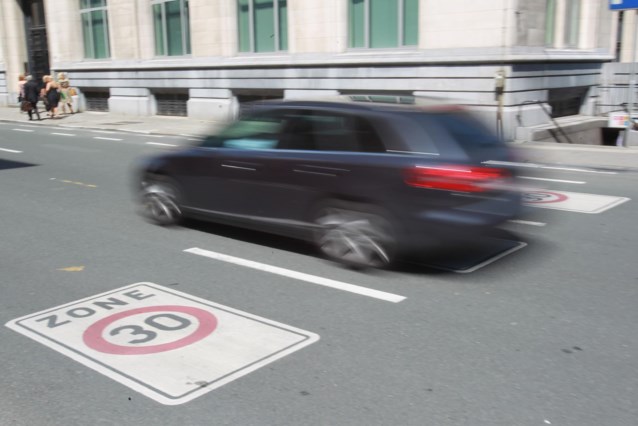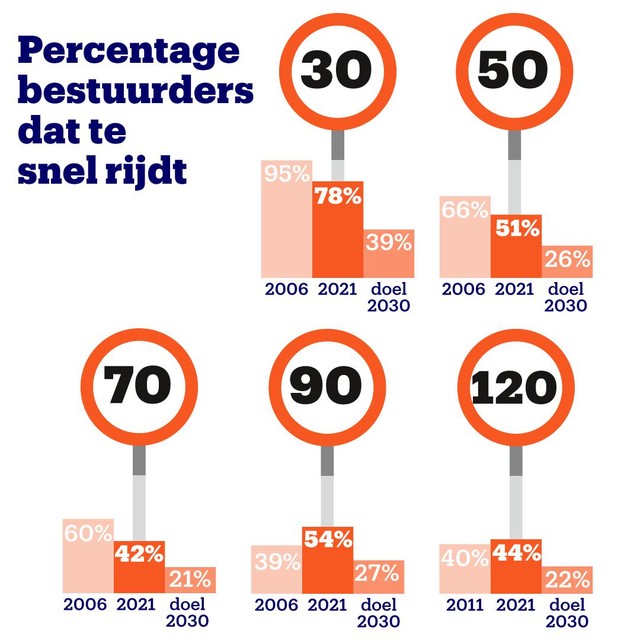Last year, 521 people died in traffic accidents and nearly 38,000 people were injured. Excessive speed is one of the main reasons. However, the numbers discourage drivers from reducing their speed, according to new speed measurements from safety institute Vias.
Check whether drivers respect the maximum speed of all speed classes. It did this with measurements at 215 locations across the country where speed is not affected by the presence of speed cameras, for example.
The numbers are alarming: although the situation has improved slightly compared to the previous measurement, at least 8 out of 10 drivers are still driving too fast in the region of 30.
track controls
The situation has worsened for roads where you can drive 50 km per hour: in the previous measurement, 36 percent of drivers were driving too fast. This has now risen to just over half. “It is possible that the speed on many roads has decreased from 70 to 50 km per hour in recent years,” says Vyas. Reduction not yet established.
Things also go from bad to worse for roads where you’re allowed 90 kilometers per hour: “In 10 years, the percentage of speeding drivers here has almost doubled,” says Vias spokesman Steve Williams. 55 percent of passing drivers drove too fast.
And what about highways? There, too, the number of drivers driving faster than 120 km per hour has increased slightly. On the grounds that driving is slower at night than during the day, the measurements show, “perhaps as a result of turning off the lights at night, which makes drivers more careful.”
Flanders is full of speed cameras and sectional checks, while Wallonia has the notion that checks are rarely or never done. However, Vyas points out that there are some key differences between how fast people drive in both parts of the country. Except on roads where you are allowed 50 per hour: in Wallonia 7 out of 10 drivers ignore the speed limit, compared to only 4 in 10 in Flanders.
What is needed to get drivers to better respect the speed limit? Especially in light of the goal of halving the percentage of drivers who drive too fast by 2030.
247 km per hour on a highway
“Different things are needed,” asserts Williams. We must continue to educate people about the dangers of speeding. Enforcement must be strengthened, with additional speed cameras or departmental controls. The driver’s license with points must also be presented, so that people who commit speeding offenses on the assembly line will be dealt with more strictly.”
The methods themselves, Vyas says, also need to be addressed. “It is still often not clear how fast you are allowed to drive somewhere, say 50 or 70 km per hour. In fact, it should be clear to drivers everywhere at a glance what the speed system is.”
Vias hopes that driver assistance systems — which can detect how fast you’re allowed to drive in a space — will soon encourage drivers not to drive faster than permitted.
The extreme cases recorded by Vias during this study prove that there is still work to be done. On the road where you are allowed 50 km per hour, a driver is found to reach a speed of just under 170 km per hour. And on the highway, it turned out that someone was driving 247 km per hour.
Minister Gilkinet: ‘Urgent action required’
According to Mobility Minister George Gilkennet (Eccolo), “urgent action is needed” to tackle excessive speeding on the road.
“The fight against excessive speed remains a major road safety issue,” said Gilkennet. “Speed, along with alcohol and distraction behind the wheel, is one of the three killers on the road.”
The minister speaks of a “cultural problem with speed” and says that “urgent action is needed”. He is considering, among other things, training drivers whose driver’s licenses have been revoked, penalties against glorifying excessive speed, progressive fines based on speeding, faster speed cameras and a more effective relapse approach.

“Total coffee specialist. Hardcore reader. Incurable music scholar. Web guru. Freelance troublemaker. Problem solver. Travel trailblazer.”








More Stories
Bitcoin price rises after new jobs data from US
European stock markets open higher | beursduivel.be
Russia’s oil imports to China decline